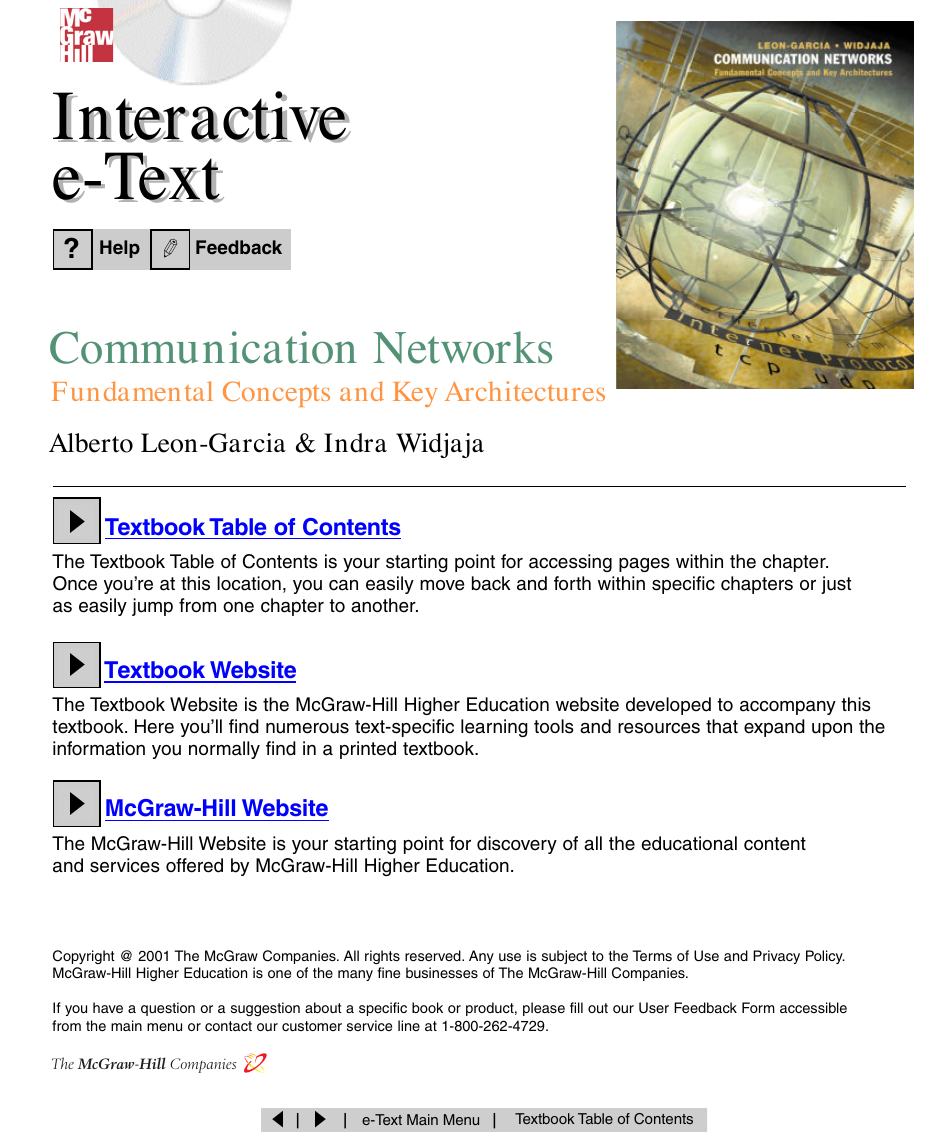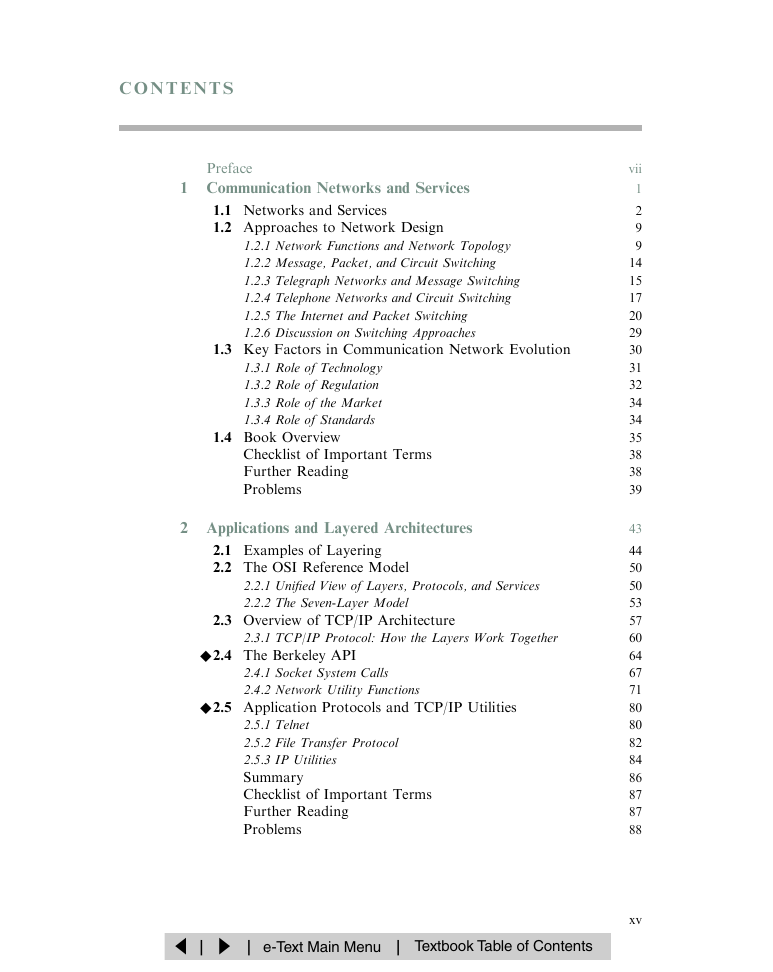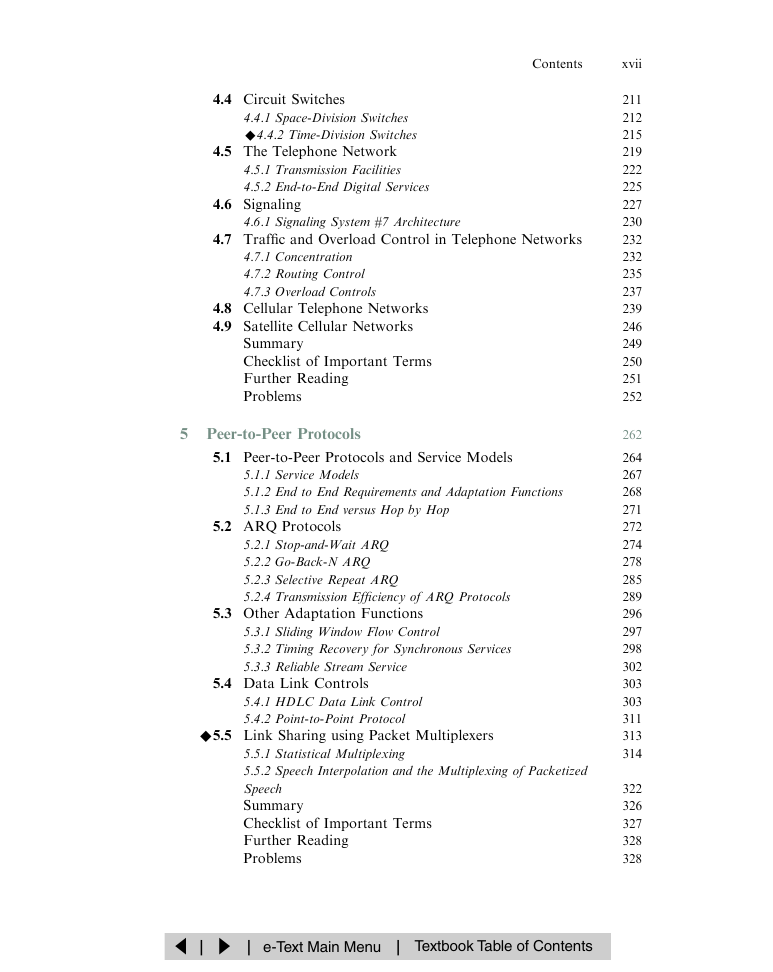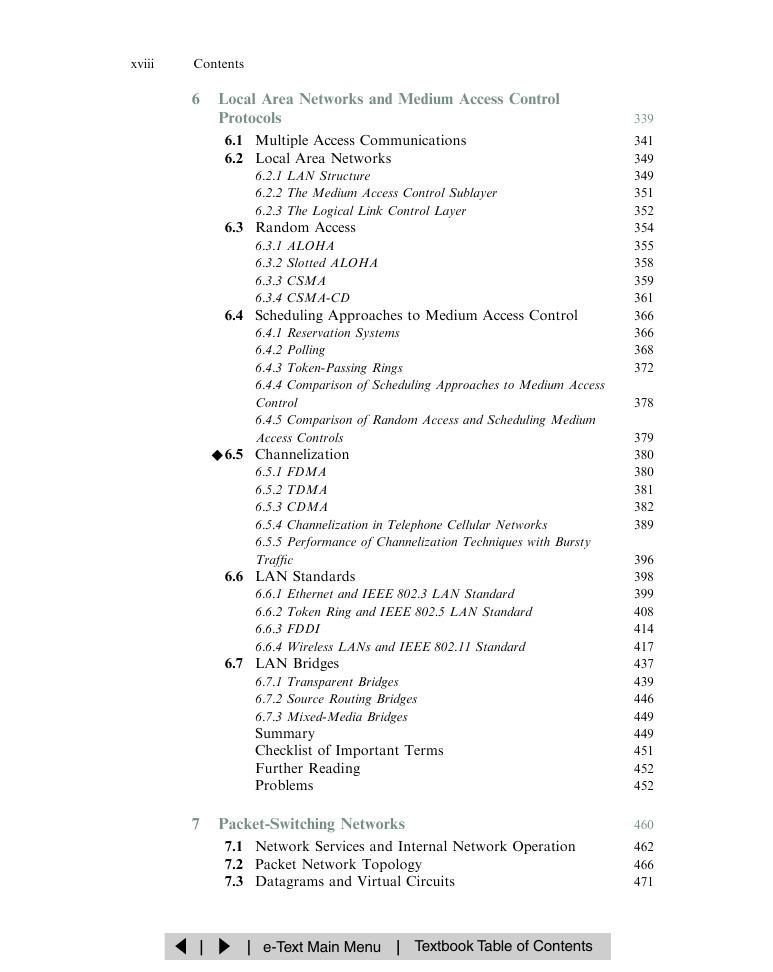help_1.pdf
Help
e-Text Main Menu
Textbook Table of Contents
main_2.pdf
Textbook Table of Contents
Chapter 1 Communication Networks and Services
1.1 Networks and Services
1.2 Approaches to Network Design
1.3 Key Factors in Communication Network Evolution
1.4 Book Overview
Checklist of Important Terms
Further Reading
Problems
Chapter 2 Applications and Layered Architectures
2.1 Examples of Layering
2.2 The OSI Reference Model
2.3 Overview of TCP/IP Architecture
*2.4 The Berkeley API
*2.5 Application Protocols and TCP/IP Utilities
Summary
Checklist of Important Terms
Further Reading
Problems
Chapter 3 Digital Transmission Fundamentals
3.1 Digital Representation of Information
3.2 Why Digital Communications?
3.3 Characterization of Communication Channels
3.4 Fundamental Limits in Digital Transmission
3.5 Line Coding
3.6 Modems and Digital Modulation
3.7 Properties of Media and Digital Transmission Systems
3.8 Error Detection and Correction
Summary
Checklist of Important Terms
Further Reading
Problems
Appendix 3A: Asynchronous Data Transmission
Appendix 3B: Fourier Series
Chapter 4 Transmission Systems and the Telephone Network
4.1 Multiplexing
4.2 SONET
4.3 Wavelength-Division Multiplexing
4.4 Circuit Switches
4.5 The Telephone Network
4.6 Signaling
4.7 Traffic and Overload Control in Telephone Networks
4.8 Cellular Telephone Networks
4.9 Satellite Cellular Networks
Summary
Checklist of Important Terms
Further Reading
Problems
Chapter 5 Peer-to-Peer Protocols
5.1 Peer-to-Peer Protocols and Service Models
5.2 ARQ Protocols
5.3 Other Adaptation Functions
5.4 Data Link Controls
*5.5 Link Sharing Using Packet Multiplexers
Summary
Checklist of Important Terms
Further Reading
Problems
Chapter 6 Local Area Networks and Medium Access Control Protocols
6.1 Multiple Access Communications
6.2 Local Area Networks
6.3 Random Access
6.4 Scheduling Approaches to Medium Access Control
*6.5 Channelization
6.6 LAN Standards
6.7 LAN Bridges
Summary
Checklist of Important Terms
Further Reading
Problems
Chapter 7 Packet-Switching Networks
7.1 Network Services and Internal Network Operation
7.2 Packet Network Topology
7.3 Datagrams and Virtual Circuits
7.4 Routing in Packet Networks
7.5 Shortest Path Algorithms
7.6 ATM Networks
7.7 Traffic Management and QoS
7.8 Congestion Control
Summary
Checklist of Important Terms
Problems
Chapter 8 TCP/IP
8.1 The TCP/IP Architecture
8.2 The Internet Protocols
8.3 IPv6
8.4 User Datagram Protocol
8.5 Transmission Control Protocol
8.6 DHCP and Mobile IP
8.7 Internet Routing Protocols
8.8 Multicast Routing
Summary
Checklist of Important Terms
Further Reading
Problems
Chapter 9 ATM Networks
9.1 Why ATM?
9.2 BISDN Reference Model
9.3 ATM Layer
9.4 ATM Adaptation Layer
9.5 ATM Signaling
9.6 PNNI Routing
Summary
Checklist of Important Terms
Further Reading
Problems
Chapter 10 Advanced Network Architectures
10.1 IP Forwarding Architectures
10.2 Overlay Model
10.3 MPLS
10.4 Integrated Services in the Internet
10.5 RSVP
10.6 Differentiated Services
Summary
Checklist of Important Terms
Further Reading
Problems
Chapter 11 Security Protocols
11.1 Security and Cryptographic Algorithms
11.2 Security Protocols
11.3 Cryptographic Algorithms
Summary
Checklist of Important Terms
Further Reading
Problems
Chapter 12 Multimedia Information and Networking
12.1 Lossless Data Compression
12.2 Digital Representation of Analog Signals
12.3 Techniques for Increasing Compression
12.4 The Real-Time Transport Protocol
12.5 Session Control Protocols
Summary
Checklist of Important Terms
Further Readings
Problems
Appendices
Appendix A Delay and Loss Performance
A.1 Delay Analysis and Little's Formula
A.2 Basic Queueing Models
A.3 M/M/1: A Basic Multiplexer Model
A.4 The M/G/1 Model
A.5 Erlang B Formula: M/M/c/c System
Further Reading
Appendix B Network Management
B.1 Network Management Overview
B.2 Simple Network Management Protocol (SNMP)
B.3 Structure of Management Information
B.4 Management Information Base
B.5 Remote Network Monitoring
Further Reading
















 2023年江西萍乡中考道德与法治真题及答案.doc
2023年江西萍乡中考道德与法治真题及答案.doc 2012年重庆南川中考生物真题及答案.doc
2012年重庆南川中考生物真题及答案.doc 2013年江西师范大学地理学综合及文艺理论基础考研真题.doc
2013年江西师范大学地理学综合及文艺理论基础考研真题.doc 2020年四川甘孜小升初语文真题及答案I卷.doc
2020年四川甘孜小升初语文真题及答案I卷.doc 2020年注册岩土工程师专业基础考试真题及答案.doc
2020年注册岩土工程师专业基础考试真题及答案.doc 2023-2024学年福建省厦门市九年级上学期数学月考试题及答案.doc
2023-2024学年福建省厦门市九年级上学期数学月考试题及答案.doc 2021-2022学年辽宁省沈阳市大东区九年级上学期语文期末试题及答案.doc
2021-2022学年辽宁省沈阳市大东区九年级上学期语文期末试题及答案.doc 2022-2023学年北京东城区初三第一学期物理期末试卷及答案.doc
2022-2023学年北京东城区初三第一学期物理期末试卷及答案.doc 2018上半年江西教师资格初中地理学科知识与教学能力真题及答案.doc
2018上半年江西教师资格初中地理学科知识与教学能力真题及答案.doc 2012年河北国家公务员申论考试真题及答案-省级.doc
2012年河北国家公务员申论考试真题及答案-省级.doc 2020-2021学年江苏省扬州市江都区邵樊片九年级上学期数学第一次质量检测试题及答案.doc
2020-2021学年江苏省扬州市江都区邵樊片九年级上学期数学第一次质量检测试题及答案.doc 2022下半年黑龙江教师资格证中学综合素质真题及答案.doc
2022下半年黑龙江教师资格证中学综合素质真题及答案.doc